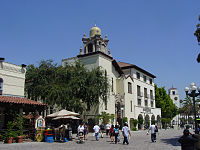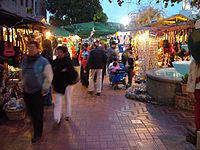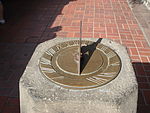- Olvera Street
-
Olvera Street is in the oldest part of Downtown Los Angeles, California, and is part of the El Pueblo de Los Angeles Historic Monument. Many Latinos refer to it as "La Placita Olvera." Circa 1911 it was described as Sonora Town.
Having started as a short lane, Wine Street, it was extended and renamed in honor of Agustín Olvera, a prominent local judge, in 1877. There are 27 historic buildings lining Olvera Street, including the Avila Adobe, the Pelanconi House and the Sepulveda House. In 1930, it was converted to a colorful Mexican marketplace. It is also the setting for Mexican-style music and dancing and holiday celebrations, such as Cinco de Mayo.
Contents
History
Early days
 The "Old Plaza Church" facing the Plaza, 1869. The brick reservoir in the middle of the Plaza was the original terminus of the Zanja Madre
The "Old Plaza Church" facing the Plaza, 1869. The brick reservoir in the middle of the Plaza was the original terminus of the Zanja Madre
Los Angeles was founded in 1781 on a site southeast of Olvera Street near the Los Angeles River by a group of Spanish pobladores (settlers), consisting of 11 families — 44 men, women, and children, accompanied by a contingent of soldiers — who had set out from the nearby Mission San Gabriel Arcángel to establish a secular pueblo along the banks of the Porciúncula River at the Indian village of Yang-na.[1] The initial settlement was dubbed El Pueblo de Nuesta Señora Reina de los Ángeles. To provide for the religious needs of the settlers, priests from San Gabriel established an asistencia (a sub-mission), the Nuestra Señora Reina de los Angeles Asistencia. As the town grew, it eventually built its own parish church, which is today known as the "Old Plaza Church." Unpredictable flooding forced settlers to move the town to higher ground. The town, complete with a church and rectangular plaza surrounded by house lots and planting fields, was placed in its current location in the early 19th century. Spanish colonial rule lasted until 1820. This period saw the first streets and adobe buildings of the town constructed. The town came under the control of newly independent Mexico in 1821. During this time of Mexican rule, which lasted until 1848, the Plaza area was the heart of Mexican community life in Los Angeles and center of an economy based upon cattle ranching and agriculture.
Hard times
For a time after the Mexican-American War and Gold Rush, the Plaza remained the center of a diverse town. The central street of the Plaza, Vine or Wine Street, was extended and had its name changed by City Council ordinance in 1877 to Olvera Street to honor Augustín Olvera, the first Superior Court Judge of Los Angeles County and long-time Olvera Street resident. In the 1880s, Los Angeles began quick expansion through a massive influx of Anglo and European settlers who arrived via the railroad. The old Plaza area became a forgotten remnant of the city's roots, and the remaining adobe and brick buildings within the Plaza area fell into disrepair as the civic center of the city shifted to present-day Temple and Main Streets.
A good view of the street during this period is to be found in Charlie Chaplin's 1921 film The Kid, which featured a number of scenes in it, mostly on the west side a few doors north of the Pelanconi House. At the time of the film, years before its makeover by Christine Sterling, it was hardly considered to be a proper street, but rather just a dingy, dirty alley.
Its decline as the center of civic life led to its reclamation by diverse sectors of the city's poor and disenfranchised. The Plaza served as a gateway for newly arrived immigrants, especially Mexicans and Italians. During the 1920s, the pace of Mexican immigration into the United States increased to about 500,000 per year. California became the prime destination for Mexican immigrants, with Los Angeles receiving the largest number of any city in the Southwest. As a result of this dramatic demographic increase, a resurgence of Mexican culture occurred in Los Angeles. It was within this social and political climate that Christine Sterling began her public campaign to save the old Francisco Avila Adobe from demolition and build up Olvera Street as a center of Mexican romance and tourism.
Preservation and restoration
Sundial at Olvera Street
Sterling's efforts to rescue the Plaza-Olvera area began in 1926, when she discovered the deteriorated conditions of the area, and in particular the Avila Adobe, the oldest existing home in the city. After raising the issue of the Avila Adobe with the Los Angeles Chamber of Commerce, Sterling approached Harry Chandler, the publisher of the Los Angeles Times with a plan to restore the building and create a colorful Mexican marketplace and cultural center in the Plaza. Chandler was intrigued by Sterling's idea for restoring the Plaza area as a mixture of romance and capitalism, and helped by providing extensive publicity and support for the development plan in The Times.
However, by 1928, due to a lack of financial support for implementing her ideas, the project appeared to be fading. In late November of that year, Sterling found a Los Angeles City Health Department Notice of Condemnation posted in front of the Avila Adobe. In response, Sterling posted her own hand-painted sign condemning the shortsightedness of city bureaucrats in failing to preserve an important historic site. Her action helped attract additional public interest in preserving the old adobe. In response to the increased show of publicity, the Los Angeles City Council reversed its original order of condemnation. Support for restoring the adobe rushed in from throughout the city. Building materials came from several local companies, including Blue Diamond Cement and the Simmons Brick Company, one of the largest employers of Mexicans in the Los Angeles area. Los Angeles Police Chief James Davis provided a crew of prison inmates to do hard labor on the project. Sterling oversaw the entire construction project, and an excerpt from her diary vividly captures her spirit and sense of desperation for financial support during the construction: One of the prisoners is a good carpenter, another an electrician. Each night I pray they will arrest a bricklayer and a plumber.
 Entrance to Olvera Street (left), Los Angeles.
Entrance to Olvera Street (left), Los Angeles.
In spite of ample supplies and forced volunteers, the project lacked solid financial backing until Chandler came forward with capital for the project through funds collected at $1,000-a-plate luncheons with selected businessmen. Chandler established and headed the Plaza de Los Angeles Corporation, a for-profit venture which became the financial basis for the restoration of Plaza-Olvera. The street was closed to traffic in 1929.
On Easter Sunday 1930, Sterling's romantic revival came to pass with the opening of Paseo de Los Angeles (which later became popularly known by its official street name Olvera Street). Touted as A Mexican Street of Yesterday in a City of Today, Olvera Street was an instant success as a tourist site. La Opinión, the leading Spanish language daily, perhaps reflecting the sentiments among many Mexicans in the city, praised the project as una calleja que recuerda al México viejo.
Present
The Plaza-Olvera Street site was designated as a California State Historic Landmark in 1953.
In the midst of Downtown industrialization, Olvera Street is a quaint, colorized, and non-confrontational environment. Olvera Street is successful in depicting the quaintness of Mexican culture. The Avila Adobe aside, however, the buildings on the street date from at least seventy years after the founding of the city in 1781, and have little if any authentic association with the city's founding, or with its former status as a Spanish, then Mexican outpost. Olvera is really a named alley, unusual in Los Angeles, rather than a true street. This can be seen from the fact that most of the buildings originally had their main entrances and addresses on the adjacent and parallel Main and Los Angeles Streets. In addition, the frontages along Olvera Street are uneven, as is typical with alleys. Nevertheless, for virtually all of its history it has been named as a street, sometimes also being identified as Wine Street, in reference to a wine cellar once located there, as well as wineries that once stood nearby.
As a tourist attraction, Olvera Street is a living museum paying homage to a romantic vision of old Mexico. The exterior facades of the brick buildings enclosing Olvera Street and on the small vendor stands lining its center are colorful piñatas, hanging puppets in white peasant garb, Mexican pottery, serapes, mounted bull horns, oversized sombreros, and a life-size stuffed donkey. Olvera Street attracts almost two million visitors per year.
Blessing of the Animals
The Blessing of the Animals is a traditional event dating to 1930 that is held every Sabado de Gloria (Saturday before Easter). The event was originally held in conjunction with the Feast Day of Saint Anthony of the Desert, but it was changed to take advantage of better weather.
The original procession has grown into an all-day event with vendors, performers, and a procession where participants bring their animals to be blessed by religious authorities and others.
The event includes an animal parade and informal displays of their pets[2] and the historical event was covered in the book Blessing of the Animals: A Guide to Prayers & Ceremonies Celebrating Pets & Other Creatures[3]
See also
- Olvera
- Pueblo de Los Angeles
- La Iglesia de Nuestra Señora Reina de los Angeles
- Avila Adobe
- History of Los Angeles
- Zanja Madre
- List of Registered Historic Places in Los Angeles
Sources
 This article incorporates text from a publication now in the public domain: Chisholm, Hugh, ed (1911). Encyclopædia Britannica (11th ed.). Cambridge University Press.
This article incorporates text from a publication now in the public domain: Chisholm, Hugh, ed (1911). Encyclopædia Britannica (11th ed.). Cambridge University Press.
References
- ^ Yenne, Bill (2004). These "pobladores" were of mostly of mixed Spanish, African, and Indian descent. The Missions of California. Thunder Bay Press, San Diego, CA. ISBN 1-59223-319-8
- ^ Olvera-Street.com - Blessing of the Animals
- ^ Blessing of the Animals: A Guide to Prayers & Ceremonies Celebrating Pets & Other Creatures
External links
- Rondeau, Ginette R. Olvera Street, 1998–2007
- El Pueblo de Los Angeles Historical Monument. City of Los Angeles.
- Guerrero, Diana L. Blessing of the Animals, 2007
Coordinates: 34°03′27″N 118°14′17″W / 34.057495°N 118.237996°W
Downtown area, Los Angeles Districts and
neighborhoodsArts District · Bunker Hill · Chinatown · Civic Center · Fashion District · Financial District · Gallery Row · Historic Core · Jewelry District · Little Tokyo · Skid Row · South Park · Old Bank District · Toy District · Wholesale District

Points of
interestAngels Flight · Broadway · City Hall · Convention Center · L.A. Live · Music Center · Olvera Street · Pershing Square · Staples Center · Union Station
Downtown · Eastside/Northeast · Harbor Area · Greater Hollywood · Westlake/Silver Lake/Los Feliz · San Fernando and Crescenta Valleys · South Los Angeles · Westside · Wilshire
Categories:- History of Los Angeles, California
- Landmarks in Los Angeles, California
- Mexican-American culture
- Streets in Los Angeles County, California
Wikimedia Foundation. 2010.



